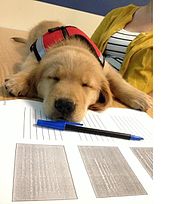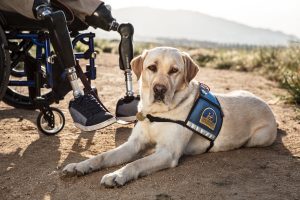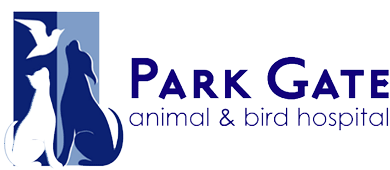It’s National Assistant Dog Month this August, which means awareness should be raised to help better understand their duties and contributions! Service dogs are so special, and there are many interesting things you can learn about them and what they do.
1. Service Dogs Can Be Any Color, Size or Breed
There’s nothing that says Service Dogs can only be Labrador Retrievers, Golden Retrievers or German Shepherds. While those 3 breeds are some of the most commonly seen Service Dogs, absolutely any dog with the proper temperament, good health and structure, and the physical capability to do the job their person needs them to do (as an example, a 30 pound dog cannot do brace and mobility support work) can be a Service Dog, regardless of color, size or breed.
2. Service Dogs Come In Multiple Varieties
Everyone knows what guide dogs are, and most people have heard of hearing dogs. People often know immediately that a dog wearing a special harness and partnered with an individual in a wheelchair is a Service Dog, although they may not know exactly what that dog does for its person. However, there are well over a dozen distinct varieties of Service Dogs, including, but not limited to:. Allergy Alert Dogs
 Autism Assistance Dogs
Autism Assistance Dogs - Brace and Mobility Support Dogs
- Emergency Medical Response Dogs
- Diabetic Alert Dogs
- Hearing Dogs
- Guide Dogs
- Medical Alert Dogs
- Medical Assistance Dogs
- Medical Response Dogs
- Psychiatric Service Dogs
- Seizure Alert Dogs
- Seizure Assistance Dogs
- Seizure Response Dogs
- Visual Assistance Dogs
- Wheelchair Assistance Dogs
3. Service Dogs Aren’t Just For Emotional Support
Service Dogs don’t just offer companionship and emotional support to their people. In fact, any dog that does that and only that isn’t a Service Dog — it’s an Emotional Support Dog. In order to be a Service Dog, a dog has to possess specialized training that mitigates some part of their handler’s disability. It can’t be a behavior the dog offers naturally, either, since that isn’t a trained behavior. It must be a specific, predictable behavior tied to a cue or trigger that the dog performs reliably in order to be considered trained task work.
4. Service Dogs Perform Specialized Work and Tasks For Their Person
Service Dogs possess specialized training that mitigates their person’s disability. Depending on the type of Service Dog, the dog may have anywhere from 3 to a dozen different tasks or even more! Some examples of Service Dog tasks include:
- Retrieving Dropped Items
- Opening and Closing Doors
- Turning Lights On and Off
- Pulling Wheelchair Up a Slope
- Waking Someone With PTSD From a Nightmare
- Licking a Seizing Person to Help End the Seizure Via Tactile Stimulation
- Burrowing Under the Legs of a Person With POTS to Help Raise Their Blood Pressure

- Alerting a Diabetic to Dangerous Shifts in Blood Sugar
- Bracing an Unsteady or Unbalanced Handler
5. Service Dog Handlers May Not Be Visibly Disabled
Lots of disabilities aren’t visible, including neurological disorders, psychiatric illnesses, diabetes and hearing loss. A person partnered with a Service Dog who doesn’t appear to have a visible disability still has a right to their Service Dog, and to not be questioned about their private medical history or diagnoses. A common question asked of people with invisible disabilities is “Are you training her for someone?” If the answer is, “No, she’s for me,” then it’s polite to not inquire further unless the handler clearly welcomes additional inquiries or offers additional information.
6. Service Dogs Aren’t Allowed “Everywhere”
Legally, Service Dogs don’t have public access rights. Their handler, who must have a disability in order to be pa rtnered with a Service Dog, has the right to access “places of public accommodation” with their Service Dog. There is a difference — it’s the person with rights, not the dog. The person has the right to not be discriminated against based on the fact they have a Service Dog. However, having a Service Dog does not magically grant a handler access to places where members of the public aren’t allowed. Exceptions to “everywhere” include churches and other places of worship, private/exclusive clubs, certain areas of zoos, aquariums and refuges where the dog’s presence could cause danger or stress to the animals within, and places where other people can be excluded, like MRI rooms and radiology, sterile laboratories or factory floors, and the ICU, cardiac and burn units.
7. Service Dog Handlers Can Only Be Asked Two Questions
When in a business or place of public accommodation, if it isn’t readily apparent that a dog is a Service Dog, the employees or person in charge may only ask two questions of the team:
- Is the animal required because of a disability? (This often takes the form of “Is that a Service Dog?”)
- What work or tasks has the dog been trained to perform? (This often takes the form of “What does the dog do for you?”)
8. Service Dogs Aren’t Required To Wear Gear
In the United States, there is no required gear for Service Dogs. A Service Dog is a Service Dog regardless of what they are or are not wearing, and their handlers possess the exact same access rights with or without their dog in gear. Vests, harnesses and jackets are very commonly seen on working Service Dog teams, but by law, the dog isn’t required to wear anything in order to work in public.
9. Service Dogs Aren’t Required To Have “Paperwork”
There is no required documentation, registration, certification or paperwork required in order for a dog to be a Service Dog. All of the above is strictly optional, and while offered by many Service Dog programs, it is not necessary by law. A Service Dog team does not have to provide proof of Service Dog status. If their legitimacy is in doubt, the dog’s outstanding behavior and obvious training, combined with the handler’s answers to the questions “Is that a Service Animal?” and “What tasks is your Service Animal trained to perform for you?” should solve the access challenge promptly.
10. Service Dogs Should Have Excellent Manners and Obvious Training
Service Dogs in public should never be obtrusive, rude, disorderly or out of control. In fact, if a dog is any of the above, and the handler is not taking appropriate action to rectify the issue, the business or place of public accommodation may ask the handler to remove the dog and return for services alone. People with a disability have a right to have their Service Dog with them, but businesses and other places where Service Dogs are allowed have a right to not have their day to day operations interrupted by a dog who isn’t ready or who shouldn’t be working in public.
Facts from anythingpawsible.com!
If you have any questions, don’t hesitate to ask us at Parkgate Animal Hospital (604-929-1863)!

